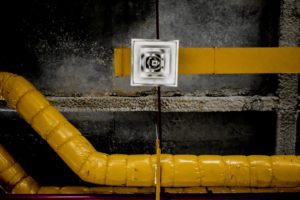Duct Sealing: The Commercial HVAC Issue That You May Have Overlooked
Ensure Peak System Performance with Proper Ductwork Installation, Maintenance and Repair

According to the U.S. Office of Energy Efficiency and Renewable Energy, commercial building owners can expect to spend up to 40% of their energy costs on heating and cooling alone. And the linchpin of any conventional HVAC system, delivering all that heated or cooled air to your offices and warehouse from your furnace, boiler, heat pump or condenser? You guessed it: the seemingly endless arrangement of pipes running through your walls we refer to as your HVAC ducts.
As you might imagine, this equipment is not only critically important to the energy efficiency of your overall system, but also prone to various problems as well. Whether installed incorrectly in parts, damaged by rodents, or wind, or heck, even your last maintenance guy who might have shifted something without realizing it, leaking or broken ductwork is a common, if undetected issue for many commercial building owners.
Signs of Leaking, Broken or Poorly Functioning Ducts
If you have any of the following HVAC complaints, you too may have a ductwork problem.
#1. An increase in dust, particulate or otherwise poor air quality in any part of your building.
Broken or damaged ductwork could be responsible for sending unfiltered air into your vents and the lungs of everyone within your building.
#2. Variations in temperature throughout your building
Cold or hot spots in certain areas could be from gaps or leaks in the ducts, resulting in inconsistent air flow for parts or all of your building.
#3. Higher than normal utility bills.
An open, broken or leaking duct means airflow is comprised, and you’re leaking money as well as heat. Your system may be working far harder than it needs to in order to maintain indoor comfort within your building.
What to Do If You Suspect a Ductwork Issue
Think of the following as a colonoscopy or a barium swallow for your HVAC system. Every inch of the ductwork should be inspected, including all seals, and connections with supply registers and your HVAC unit itself. Any part that’s missing or unable to be repaired should obviously be replaced at once. That includes pieces that are bent, dented or are in less than perfect shape.
Sealant should also be utilized to both repair and reseal any areas that have gaps or loose seams where air can escape. Your technician may use screws, metal tape, mastic or all three to do the job. It’s worth pointing out that standard duct tape is not the sealant of choice, in that it can be easily damaged by moisture or excessive dryness. Both conditions cause it to loosen over time.
While broken ductwork doesn’t necessarily make any noise, it’s a problem that in the end will cost you money in lost heating or cooling. Maintain it properly and enjoy your indoor comfort knowing you’re getting the most from your HVAC system.
Need commercial HVAC ductwork inspected for leaks or gaps? Call the experts at Air-Tro. We’re the name the San Gabriel Valley trusts for all their heating and air conditioning needs. (626) 357-3535.
